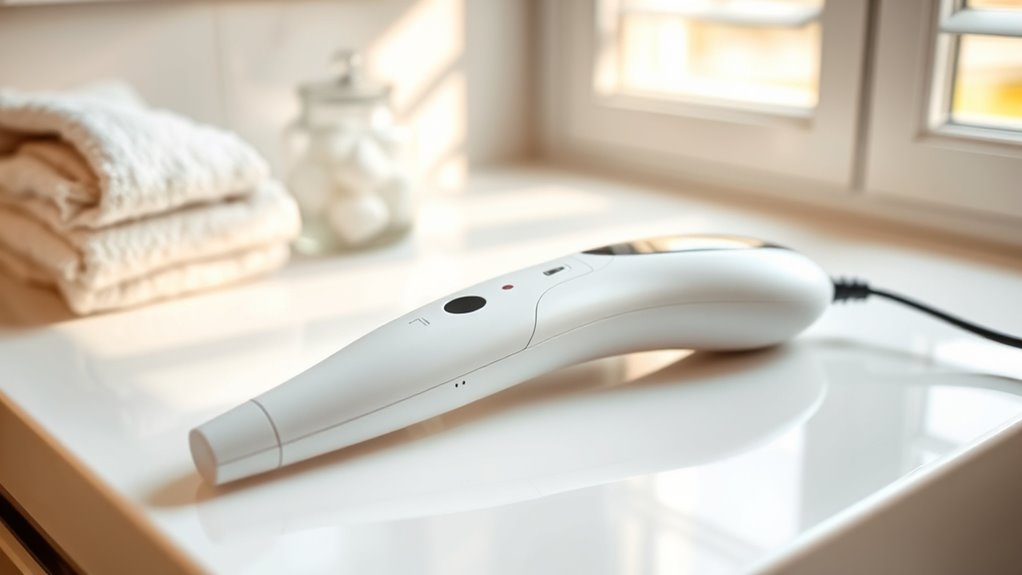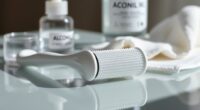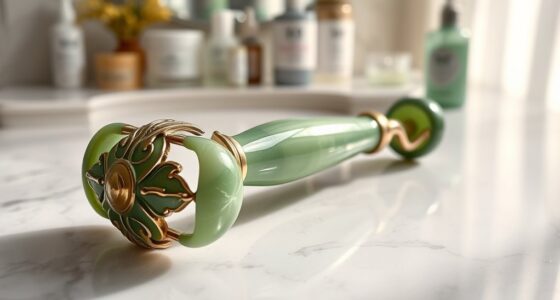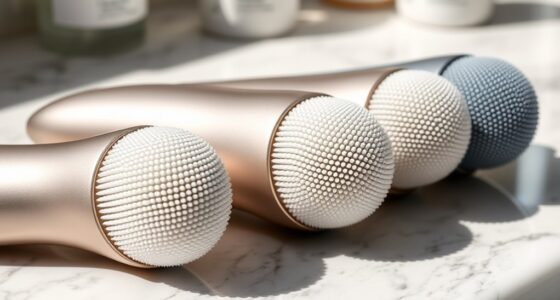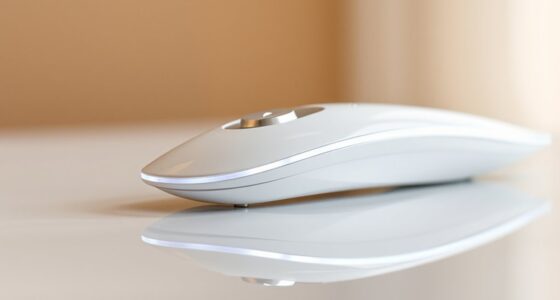Before trying an at-home IPL device, make sure it’s suitable for your skin and hair type—these devices work best on fair skin with dark hair. Follow all safety instructions, start on the lowest setting, and do a patch test first. Avoid overuse and protect your skin from sun exposure afterward. Ignoring these guidelines can cause burns or pigmentation issues. If you want to stay safe and get the best results, there’s more you should know.
Key Takeaways
- Ensure your skin tone and hair color are suitable for IPL treatment to prevent burns and ineffective results.
- Follow manufacturer instructions carefully, starting with the lowest setting and performing patch tests first.
- Avoid using creams, lotions, or oils before treatment to ensure proper light absorption and safety.
- Protect your skin from sun exposure before and after treatment to reduce risk of pigmentation changes.
- Do not overuse the device; follow recommended schedules to avoid skin damage and achieve optimal results.
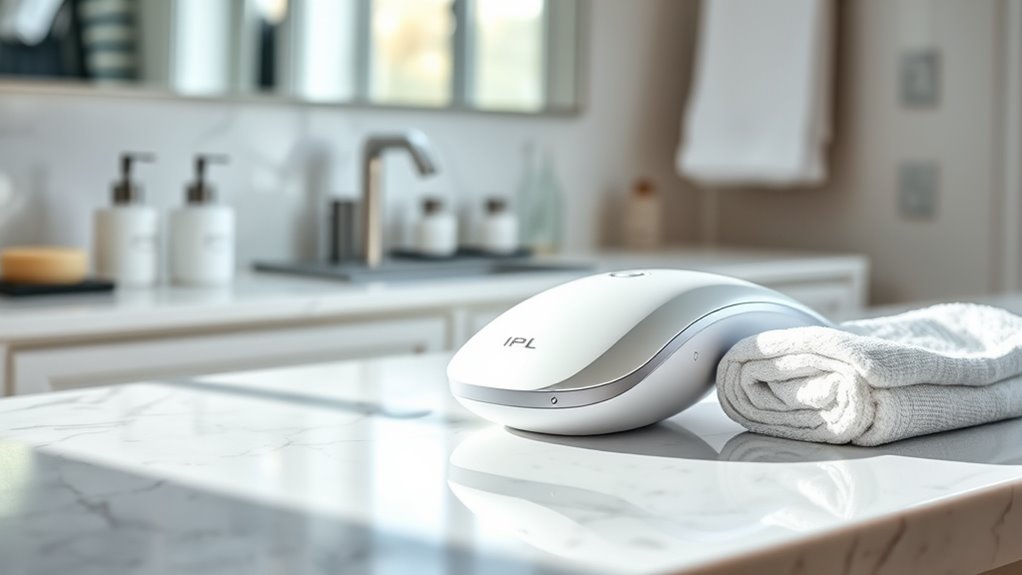
Considering an at-home IPL device? Before you dive in using it, it’s crucial to understand what you’re getting into. Intense Pulsed Light (IPL) devices are popular for hair removal, skin rejuvenation, and reducing pigmentation. They promise salon-quality results from the comfort of your home, but they also come with risks if not used properly. Knowing the ins and outs can help you decide whether this is the right choice and how to do it safely.
First, you need to assess your skin type and hair color. IPL works best on people with fair skin and dark hair because the light targets melanin. If your skin is darker or you’ve got lighter hair, the device may be less effective and could increase your risk of side effects like burns or pigmentation changes. It’s essential to read the manufacturer’s guidelines to see if your skin tone and hair color qualify. Ignoring these recommendations could lead to discomfort or even skin damage.
Assess your skin and hair color to ensure IPL safety and effectiveness.
Next, familiarize yourself with the device’s settings and features. Most at-home IPL devices come with adjustable intensity levels. Start on the lowest setting to see how your skin reacts, then gradually increase if you don’t experience any adverse effects. Skipping this step or jumping straight to higher settings can cause burns, redness, or irritation. Always perform a patch test on a small area before treating larger patches. This helps you gauge your skin’s response and prevents potential complications.
Proper preparation of your skin is also essential. Shave the area you plan to treat beforehand; this ensures the light targets the hair follicle directly and reduces the risk of burns. Avoid applying creams, lotions, or oils before treatment—these can interfere with the light’s effectiveness. Make sure your skin is clean, dry, and free of any products that could block the light or cause reactions. Additionally, understanding the technology behind IPL devices can help you better operate and troubleshoot them effectively.
During treatment, follow the device’s instructions carefully. Hold the device steadily against your skin, and don’t press too hard—just enough to keep it in contact. Move it smoothly across the area without over-treating any spot. Overuse or excessive sessions won’t necessarily speed up results and could damage your skin. Most devices recommend a specific treatment schedule, and sticking to it ensures safety and effectiveness.
Finally, aftercare is just as important. Protect your skin from the sun, as IPL increases photosensitivity. Use sunscreen daily and avoid sun exposure for at least two weeks after treatments. If you notice redness, swelling, or blistering, don’t ignore these signs. Give your skin time to recover, and if symptoms persist, consult a healthcare professional. By understanding these precautions and following instructions carefully, you can maximize your results while minimizing risks.
Frequently Asked Questions
Can I Use an IPL Device on Sensitive Areas Like the Face or Bikini Line?
You can use an IPL device on sensitive areas like your face or bikini line, but you must do so cautiously. Always follow the manufacturer’s instructions and use the appropriate settings for delicate skin. Perform a patch test first to check for reactions, and avoid areas with broken skin or moles. If you’re unsure or have skin conditions, consult a dermatologist before proceeding to ensure safety and effective results.
How Long Does It Take to See Results From At-Home IPL Treatments?
Rome wasn’t built in a day, and neither are smooth, hair-free skin. You’ll typically see noticeable results from at-home IPL treatments after about 4 to 8 sessions, spaced a few weeks apart. Consistency is key, so stick to your schedule. Some people notice improvement sooner, while others may need more treatments. Patience and regular use will help you achieve the best long-term results.
Are There Any Skin Types or Hair Colors That IPL Devices Cannot Treat?
You should know that IPL devices work best on light to medium skin tones and darker hair. They’re less effective on very dark skin or very light hair, such as blond, gray, or white hair, because the light targets pigment. If you have a tan or recent sun exposure, it’s better to wait, as IPL can cause burns or pigmentation issues. Always check your device’s guidelines for safe use.
What Should I Do if I Experience Discomfort or Skin Irritation?
If you experience discomfort or skin irritation, stop using the device immediately. Gently soothe your skin with cool compresses or aloe vera. Avoid sun exposure and keep the area moisturized. If irritation persists or worsens, consult a healthcare professional promptly. Remember, listening to your skin is key; don’t push through pain or discomfort, and always follow the device’s safety guidelines for safe use.
How Often Should I Repeat Treatments for Optimal Results?
For the best results, follow your device’s recommended schedule—usually every 2 to 4 weeks. Consistency is key, so stick to the suggested timing without skipping sessions. Don’t delay or double up, and always listen to your skin’s signals. If you notice irritation or discomfort, pause treatments and consult the instructions or a professional. Proper patience and punctuality will help you achieve smooth, stunning results safely.
Conclusion
Before trying an at-home IPL device, remember that over 80% of users see noticeable hair reduction within just a few sessions. However, it’s vital to follow instructions carefully to avoid skin irritation or damage. Doing your research and starting with a patch test can make all the difference. Stay cautious, stay informed, and enjoy smoother skin safely. Your journey to hair-free confidence begins with the right knowledge—so, read up and proceed wisely!
